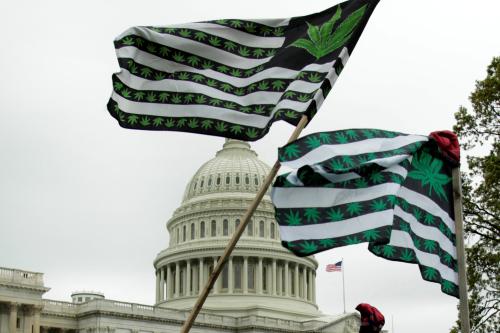The 2020 election season will be a transformative time for cannabis policy in the United States, particularly as it relates to racial and social justice. Candidates for the White House and members of Congress have put forward ideas, policy proposals, and legislation that have changed the conversation around cannabis legalization. The present-day focus on cannabis reform highlights how the War on Drugs affected targeted communities and how reform could ameliorate some of those wrongs. The national conversation on cannabis stands at a pivotal inflection point that provides policymakers and legislators with an extraordinary opportunity to establish a policy context wherein inclusive economic opportunities can thrive in tandem with responsible investments to redress longstanding harms.
When Congress works to remedy a discriminatory past or to rectify decades of institutionalized bias, it has an obligation to thoroughly consider implicit and explicit hurdles to equity. Nowhere is this deliberation more critical than in drug policy reform. For decades, the criminalization of drugs led to foreclosed opportunities for people of color who were disproportionately victimized by unequal criminal enforcement. In 2013, police officers were 3.73 times more likely to arrest people of color for cannabis possession than whites. Arrest disparities were even more egregious in some communities where Blacks were 8.3 times more likely than whites to be arrested for possession.1 The racist roots of the War on Drugs inflicted significant collateral damage on minority groups, saddling young men and women of color with drug convictions—often before age 30—and setting them on a course of institutionalized disadvantage because of the crippling, collateral consequences of criminal records.
Today, amidst a thriving state-legal cannabis industry, the same people hurt most by the drug war face the greatest barriers to participating in the emerging cannabis economy. As elected officials consider how to reform the nation’s cannabis laws and rectify these serious socioeconomic and racial issues, they must erase any ambiguity about the protections, corrective actions, and inclusive opportunities intended to reverse the generation-long ills of the War on Drugs. We argue that 2020 is an opportune moment to design a comprehensive pragmatic Cannabis Opportunity Agenda: a set of policies that addresses the social harms of marijuana prohibition and seeks to rehabilitate impacted communities with a focus on equity, opportunity, and inclusion.
Key goals of a comprehensive Cannabis Opportunity Agenda
We argue that a Cannabis Opportunity Agenda, aimed at mitigating the effects of the drug war, must combine different parts of existing proposals. At the same time, to ensure the equitable distribution of inclusive opportunities it is critical to think differently about legislative design and implementation. We argue that such an agenda must include five critical features:
- expungement of cannabis-related criminal records;
- a well-defined class of beneficiaries;
- protections for the physical communities most ravaged by the War on Drugs;
- enable minorities to enter and successfully persist in the cannabis economy; and
- transformative interventions that reduce invisible institutional barriers to opportunities.
Holistic expungement design
Proposals calling for criminal record expungement alone are not enough. Cannabis Opportunity legislation must be clear and unambiguous in its intent to undo harm; acknowledging the need for a holistic approach to record expungement is a crucial first step. In addition to expungement, proposals should include provisions regulating the commercialization of federal criminal justice data and funded mandates empowering criminal justice agencies to enact record protection measures proactively.
Several cannabis reform proposals in Congress include record expungement clauses. Most proposals contain brief edicts directing courts to expunge records of individuals convicted of cannabis possession. Senator Kamala Harris’ ambitious MORE Act, alone, explicitly calls for juvenile convictions to be sealed and recognizes the administrative and technical complexities of effectuating record expungement; her proposal lays out a near-comprehensive roadmap addressing bureaucratic hurdles, such as notification and court petitions, and proposes sentencing and re-sentencing guidance.
Sealing or expunging records on its face seems perfectly reasonable. On the one hand, sealed records limit public access, while remaining accessible to law enforcement agencies and courts for sentence enhancement and charge determinations. Expungement, on the other hand, purports to erase convictions or arrest records in criminal databanks. However, the utility of sealing an expungement is increasingly questionable. In the era of big data and algorithmic decision-making, the use of criminal public records is ubiquitous. Personal criminal justice data (regardless of accuracy or currency) are widely available, inexpensive, and frequently used by employers, licensing authorities, and landlords to shape their choices. The prevalence of criminal records, fueled by low-barriers to access, can make expungement a futile effort in achieving the policy’s goals.
An often-overlooked part of the expungement conversation involves the need to expunge state-level convictions. Although the federal government cannot mandate state expungement, it can incentivize such behaviors through funded mandates. The capacity to effectuate expungement at scale must be funded. Admirably, Senator Chuck Schumer’s bill is the only advanced proposal that provides a substantial funding stream targeted at states to support expungement activities. Schumer’s Marijuana Freedom and Opportunity Act pledges 50 percent of expungement allocations to under-resourced public defenders and legal aid organizations. Though a shift in policing and regulation at the federal level is a necessary and influential signal, the burden of ameliorating the harms of over-policing cannabis rests with states.
The next president must consider the complexities of expungement policy, the difficulty of the criminal justice bureaucracy, and states’ needs in this space. Whoever takes the oath of office in January 2021 should immediately organize a presidential task force on cannabis crime expungement, gathering together advocacy organizations, researchers, former prisoners, and state policymakers to have a comprehensive conversation around this issue. The task force should be charged with making recommendations to Congress, the executive branch, and the states about the best path to ensure that comprehensive expungement policy is both achievable and successful.
A well-defined class of beneficiaries
A hallmark characteristic of effective legislation is the unequivocal, time-invariant definition of intent to provide protections or benefits to a well-defined class of beneficiaries. Long-standing discriminatory cannabis policies have wreaked inestimable damage on communities of color. Disentangling the compounded economic and social harms of a single marijuana arrest that occurred decades ago is impractical. Attempting to estimate individual-level restitution (beyond expungement) disadvantages past offenders; we can better estimate and mitigate the harms of recently affected individuals than those hurt in the distant past.
Instead, we need to develop a restorative model that distributes broad based benefits to whole communities. Senator Cory Booker’s proposed Marijuana Justice Act offers a launch point that facilitates consideration of the negative effects communities writ large suffered as a consequence of the War on Drugs, in addition to individual-level harms. This bill seeks to reduce law enforcement and federal prison funding by punishing states that refuse to legalize cannabis and maintain racial disparities in arrest rates. A similar, if inverse, indexing approach can be used not to punish certain jurisdictions but to build them up through community development funding. Allocating such funding at the state or local level based on the capriciousness of historical and current racial disparities could channel funds into targeted communities. This can be achieved by employing data on cannabis arrests and convictions by neighborhood, a variety of indicators of crime, and measures of poverty and educational outcomes.
Federal policymakers should look to the model employed in the state of Illinois. This program identifies specific census tracts as “Disproportionately Impacted Areas” based on rates of poverty, the federal free lunch program recipients, SNAP recipients, unemployment, and cannabis arrest, conviction, and incarceration rates. A similar federal program could require prospective recipients to demonstrate their eligibility for such funding using similar criteria.
Regardless of the precise eligibility, this legislation must explicitly state which communities are to be targeted or the precise manner in which those communities are to be identified to be eligible for Cannabis Opportunity Agenda funding, and specifically what an eligibility system looks like. Excessive discretion to the executive could diminish the intent of such programs.
Protections for the physical communities most ravaged by the War on Drugs
Even as states make incremental progress toward legalizing cannabis, the indelible stain of the War on Drugs will continue to shape a socially conservative attitude toward the industry—at least until meaningful opportunities and investments begin to deliver real returns for the communities most harmed. Cannabis markets need physical spaces to trade their fare. We should at least learn lessons from the decades of zoning wars over the placement of affordable housing and check-cashing stores in many communities. For all the benefits that cannabis entrepreneurship offers, most affluent neighborhoods will not tolerate retail marijuana establishments in their backyards or near their schools. A Cannabis Opportunity Agenda must include protections for the physical communities most ravaged by the War on Drugs. Programs must be in place to guard against a historically common effort by communities to put certain classes of businesses in minority neighborhoods and neighborhoods with high levels of poverty, as more politically powerful, wealthy, and white voices lobby for zoning NIMBYism to win the day.
We propose that Cannabis Opportunity Agenda funding be earmarked to assess the public health and safety effects of the spatial distribution of marijuana retail in communities with high concentrations of poverty. In the interim, significant funding should be concomitantly allocated to support community programs that provide positive proactive buffers to the communities most at risk for retail cannabis saturation. President Barack Obama’s Promise Zone initiative provides a blueprint for targeting federal resources to underserved neighborhoods, which can be readily adapted to reducing the risk of the spatial concentration of retail cannabis in fragile communities. These designations, predicated on the principle of collective impact, sought to target economically distressed communities and strengthen their capacity to improve the quality of life for residents. Through a combination of preferential access to federal funds, designated liaisons to navigate federal agency bureaucracy, and explicit cross-sector partnerships, the Promise Zone initiative enhanced the ability of local communities to accelerate job creation, broaden educational opportunities, expand access to affordable housing, and improve public safety.
Enable minorities to enter and successfully persist in the cannabis economy
The SAFE Banking Act addresses a consequential barrier to mainstream financial services for cannabis-related businesses. Similarly, other proposals include statutory mandates that decrease barriers to basic banking services and open the SBA’s capital pipelines to cannabis-related businesses. It would be naïve to assume that access to banking and capital translates to entrance into the cannabis economy. Despite SAFE’s progress, substantial hurdles remain for minority entrepreneurs hoping to enter and compete in the cannabis industry.
Unfortunately, too many cannabis advocates focus on the narrow goal of access or entrance into the cannabis industry. This myopic viewpoint has led state legislators and members of Congress to over rely on calls for license set-asides as a tool to achieve equity in this industry. License set-asides should be part of the toolbox, but they should not be the only instrument. In fact, license set-asides presume that the only pathway forward for harmed communities involves a life grounded in cannabis. We argue that coupling license set-asides with policies aimed at enabling minority cannabis entrepreneurs to persist in the industry and extract profits that can be invested in non-cannabis pursuits would be more effective.
Former Representative Beto O’Rourke’s cannabis plan pinpoints exorbitant license fees as a barrier to minority entrance to cannabis entrepreneurship. He rightly contends that fee waivers should be a part of the economic participation toolbox to facilitate market entry for minority groups; however, this policy does not ensure persistence. Significant hurdles to persevering as a cannabis entrepreneur remain, namely compliance and taxes. Excessive regulation at the state and/or federal level can create barriers to entry that make it harder for non-traditional business owners to succeed and thrive. In many cases, those non-traditional business owners include people of color, women, young people, and new entrepreneurs. Policy proposals are woefully incomplete when they fail to define what a regulatory apparatus will look like and how regulatory choices will have significant distributive effects that can have an outsized impact for communities of color, women, and young people.
Regulatory compliance is costly for any business operating in a highly regulated market. The consumer financial services market provides a timely parallel. According to Rice University’s Baker Institute for Public Policy, compliance costs in the banking industry increased by $50 billion per year since Dodd-Frank’s passage in 2010.2 In any industry facing only a fraction of the Baker Institute’s estimate, the cost of regulatory compliance would be disproportionately burdensome for small businesses and even more so for under-capitalized minority entrepreneurs. Inspired by the systematic funding structures from Sen. Schumer’s bill, we propose that a portion of cannabis revenues be allocated to funding annual compliance grants to minority-owned small businesses in the cannabis industry for their first five years. Alternatively, that revenue could be used to authorize and fund compliance technical assistance units within state and local government agencies, which could provide standardized guidance and assistance to minority-owned small businesses and enable them to minimize system-wide compliance risk proactively.
Beyond compliance, differential tax treatment of marijuana-derived profits continues to impede persistence and profitability among cannabis-related businesses. The risk of failure from insufficient revenues is disproportionately higher for under-capitalized minority cannabis entrepreneurs. Descheduling cannabis would naturally resolve cannabis industry challenges around taxation, but bipartisan congressional support for descheduling has yet to materialize. In the absence of descheduling, however, we recommend that Cannabis Opportunity legislation recognize that comprehensive carve-outs are a necessary step toward curtailing the distorting effect of current policy. Reforming laws such as the Internal Revenue Code’s section 280E, opening SBA loan programs for the cannabis industry, expanding crop loss protections at USDA, and asserting legislative mandate that state-legal cannabis businesses should not be discriminated against relative to other businesses in terms of eligibility for federal business and agricultural programming that would help level the playing field within the industry.3
Access to opportunity in the cannabis economy is almost always framed through an entrepreneurial lens and ignores the sector’s impressive job creation track record. Leafly, a cannabis research firm, estimates that the cannabis industry employed more than 211,000 full-time workers as of 2019. What’s more, these employment estimates increased by 40.2% after accounting for 85,000 full-time indirect workers who provide auxiliary supportive services to cannabis-related businesses.4 The cannabis ecosystem, like other industries, depends on a robust workforce of varied skill levels and roles to support businesses in the cultivation, distribution, and retail of cannabis. The growing number of companies directly involved in cannabis production will assuredly lead to increased demand for trained workers to fill job vacancies. In California alone, cannabis job openings are projected to surge by 21% in 2020.
Collectively, these employment estimates suggest impending employment growth that includes employment opportunities for low-skill workers. We recommend applying the same carve-out principles to strategic federal workforce training funding authorized under the Workforce Innovation and Opportunity Act and Veteran’s Employment and Training Service programs to help marginalized low-skill workers, many of whom were directly impacted by the War on Drugs, capture new cannabis jobs. A carve-out bill authorizing funding recipients to use federal workforce funds would be a paradigm shift that enables workforce training providers to offer individuals skills-based training, connections to apprenticeships, and assistance with job placement in cannabis jobs.
Presidential leadership would represent a sea change moment for the Cannabis Opportunity movement. The next president should issue an executive memorandum to all federal agencies to examine ways in which they can use existing legislative authority and regulatory power to reform their policies to be more inclusive of the cannabis industry and particularly the industry’s entrepreneurs who come from drug war-targeted communities. That inter-agency assessment should also report to Congress about areas in which legislative reforms could facilitate such a system.
Anti-cannabis biases have pervaded many parts of American society, including the public sector, and misguided biases continue to weaken Congress’ resolve to deschedule cannabis, which ultimately would allow federal programs to support the industry’s incubation. Congress must include legislative mandates that signal to the executive branch that these programs are intended to promote active engagement with the cannabis industry rather than tacitly treating legal cannabis similarly to prohibited cannabis.
Transformative interventions that reduce invisible institutional barriers to opportunities
Simply helping cannabis businesses is a deeply flawed approach to helping the communities most damaged by cannabis prohibition. We need to interweave policies aimed at individuals, small businesses, and communities to achieve equity. Policies that dominate cannabis reparations are unevenly skewed toward access to credit, banking, and record expungement. Even Beto O’Rourke’s proposal, the most comprehensive and progressive of the lot, merely enumerates policy areas to be targeted and is illustrative of the lack of depth of thought leadership. The Cannabis Opportunity Agenda should use the American Recovery and Reinvestment Act—the 2009 stimulus law—as the model for how to get targeting right. The stimulus law was effective in part because it went line by line, program by program through the federal budget to target funding to areas at levels that would be most effective in helping the broader American economy recover from the Great Recession.
The same should be done with Cannabis Opportunity funds. No candidate for president or member of Congress has moved beyond simply listing policy areas to be addressed. There is no excuse for such ambiguity. As mentioned above, legislators should seek to limit executive branch discretion as much as possible with an eye toward ensuring that any policy is aligned to its intended outcomes. Delegation to the executive branch provides an opportunity for presidents and political appointees to hijack funding and redirect it in less effective ways or to target communities less marred by the drug war.
Conclusion
Although the recent push for racial and social justice has created some tension in the cannabis reform advocacy movement, it is not a sign of trouble or weakness. Instead, this change or enhancement to the types of issues that are center stage in the conversation shows a public policy that is maturing and transforming to reflect the diverse interests involved in legislative coalition building. This competition of ideas can be a fierce one, but it must also be one that allows space for better ideas to rise to the top and for popular ideas to be amended to overcome their own weaknesses. The broader cannabis advocacy movement was able to build coalitions effectively to pass dozens of legislative proposals. Now, it is incumbent on legislatures to do the same to define and refine the details of what future cannabis reform looks like.
This work is licensed under the Creative Commons Attribution-NonCommerical-NoDerivatives 4.0 International License. To view a copy of the license, visit https://creativecommons.org/licenses/by-nc-nd/4.0/.
-
Footnotes
- American Civil Liberties Union Foundation. (2013). The War on Marijuana in Black and White. The War on Marijuana in Black and White. New York, NY. Accessed at: https://www.aclu.org/sites/default/files/field_document/1114413-mj-report-rfs-rel1.pdf
- https://www.bakerinstitute.org/media/files/files/0febf883/bi-brief-090619-cpf-doddfrank.pdf
- Multiple legislative proposals in Congress take some of these piecemeal steps; however, in a policy environment in which de-scheduling is not achievable, a comprehensive set of carveouts, bundled together, is a necessary part of a Cannabis Opportunity Agenda.
- Leafly and Whitney Economics (2019). Special Report: Cannabis Jobs Count, accessed at: https://d3atagt0rnqk7k.cloudfront.net/wp-content/uploads/2019/03/01141121/CANNABIS-JOBS-REPORT-FINAL-2.27.191.pdf











